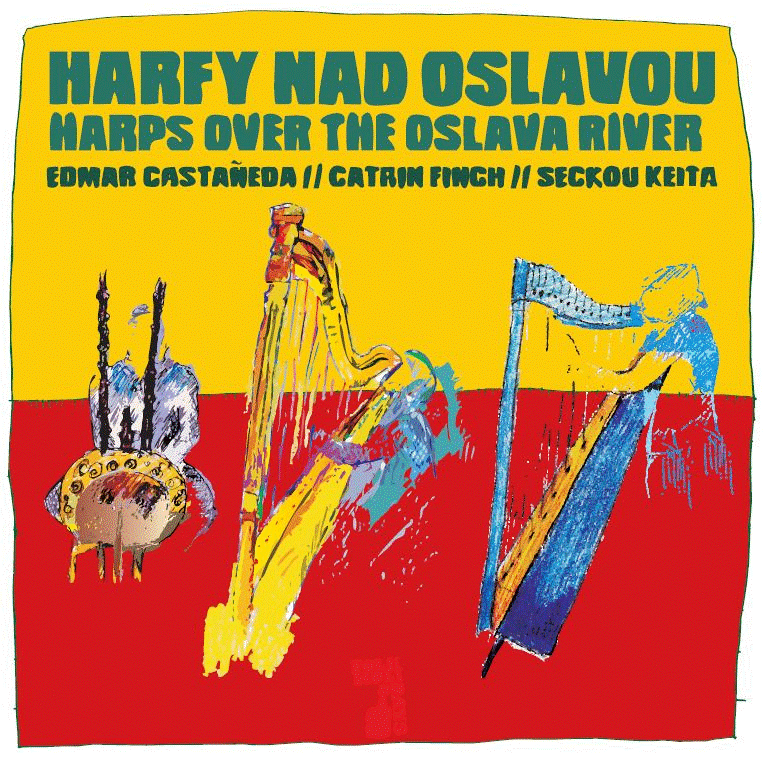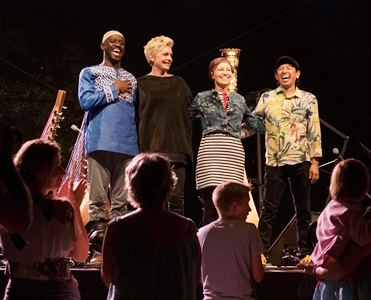
HARPS OVER THE OSLAVA RIVER
EDMAR CASTAÑEDA // CATRIN FINCH // SECKOU KEITA
CD/LP - The live record was taped on Festival Folk Holidays in Czech Republic, Náměšť nad Oslavou in 2019 2nd August.
Listen/buy: https://www.indies.eu/support/tunevoyage/folkovky
Sound: David “Hejsa” Hýsek (OteSound)
Recording – Vojtěch Šmid
Editing, mastering – Bronislav Šmid
Grafická úprava/graphic: Rostislav Pospíšil
Album is dedicated to Jitka Šuranská.
1. Harps over the Oslava river – part 1 /// 2. Harps over the Oslava river – part 2 /// 3. Harps over the Oslava river – part 3 /// 4. Harps over the Oslava river – part 4 /// 5. Harps over the Oslava river – part 5 /// 6. Harps over the Oslava river – part 6 /// 7. Harps over the Oslava river – part 7 /// 8. Po zahrádce chodila

When talking about strings, why don’t we talk about harps, moreover, from three different continents? Catrin Finch from Wales, a kora player from Senegal Seckou Keita and a Colombian musician Edmar Castañeda had met on various festivals, but it was for the first time here, on Folk Holidays, where their harps had a chance to create beautiful melodies together, which will stay in your hearts for the whole journey around the world.
Within the first tones we know that something extraordinary is going on, an intensive musical experience, which hasn’t been planned before. It could be discussed why there are just numbers on this record instead of names, but how can we name the pieces, if the musicians themselves couldn’t find the names. They asked a dramaturg of the festival to name them, so that he had spent a couple of white nights thinking, but he finally gave up and left the numbers there.
Although it wouldn’t be fair to forget all previous projects, Harps over the Oslava River are on the top, because of their musical uniqueness, where expressivity meets lyricism and masterly played music combines with humanism. Many thanks belong also to the girl, who sings Moravian folk song in the end: Jitka Šuranská.
Jiří Moravčík (www.world-music.cz)
CATRIN FINCH & SECKOU KEITA
Catrin was a bit worried about spirituality and trance rhythms of kora at first, Seckou considered harp a conservative instrument. Since none of them expected much from an offer to perform together, they didn’t even think about a project of their own, so that a result and a huge success was a nice surprise for both. Their wonderful albums Clychau Dibon and Soar combine wavy harmonies of the harp and staccato of kora. They chose birds to represent their music, they symbolise freedom, free spirit and the right of home.
They play gently on all of their forty-seven, or better to say twenty-one, strings, because kora is considered to be an African harp. Catrin was named the Royal Harp Player by prince Charles in 2000. This is a title, which was last used 130 years ago under the reign of Queen Victoria. She is a respected music star, who has performed with the best world’s symphonies. A kora player, singer, drummer and a respected musician belongs to griots, who are born in West Africa to be professional musicians, living contemporaries of the nation, and mouthpieces of the society since the 12th century. A native from Senegal region of Casamanche has been living in British Birmingham since 1996 and he is respected for his musicality and cooperation by musicians such as Martin Simpson, Baka Beyond, Omar Sosa or Damon Albarn. “I believe that everything that comes from your heart goes into someone else’s heart,“ says Seckou, nicknamed The Moving Man.
www.catrinfinchandseckoukeita.com
EDMAR CASTAÑEDA
 When coming to the counter at the airports carrying such a big instrument he introduces himself: “Hello, I am an angel playing the harp. Can you help me?“ and you will understand after his concert that it’s simply true.
When coming to the counter at the airports carrying such a big instrument he introduces himself: “Hello, I am an angel playing the harp. Can you help me?“ and you will understand after his concert that it’s simply true.
He moved to New York at the age of sixteen to study jazz trumpet, he tried to make some money by playing in clubs. He studied trumpet in the day day while trying out his newfound knowledge on the harp at a restaurant gig in the night. He developed his unique style soon. He plays the harp like hardly anyone else on earth. His hands, seemingly powered by two different people, produce a totally unique, symphonic fullness of sound, a rapid-fire of chords, balance of melodic figures and drive. His original style is a mixture of jazz and tropo.
The Joropo is a musical style, a part of Colombian folk festivals and Venezuelan Los Llanos. I tis based on the sound of harp and voices reminding Gypsies from Andalusia. The roots of the Joropo can be found in Spain. It includes fast and slow dances, poetry improvisation called contrapunteo, epic songs, sentimental ballads, cowboy songs but it can be also performed an instrumental way only.
Combining jazz and the Joropo was not a problem for Castañeda, since he is also a master of improvisation. Soon he belonged to number one jazz performers: next to Wynton Marsalis, John Patitucci, Marcus Miller, John Scofield and mainly the best world’s jazz pianist Hiromi. “During our sound check we found out, how easily and magically we linked up. It seemed that all notes we played were happy to be together and started to dance, “remembers a Japanese virtuoso her first cooperation with Castañeda. Now they are one of the most shining musical duos. However, we can also remember him from the concerts and records with Marta Töpferová, Sting, Paco de Lucia, Mexican singer Lila Downs or the best world’s symphonic orchestras.
www.edmarcastaneda.com
Photograph´s authors: 1. Kamila Berndorffová, 2. Ivan Prokop


